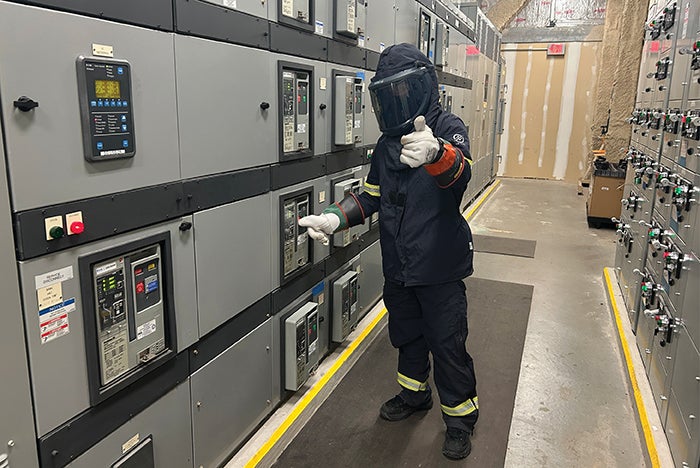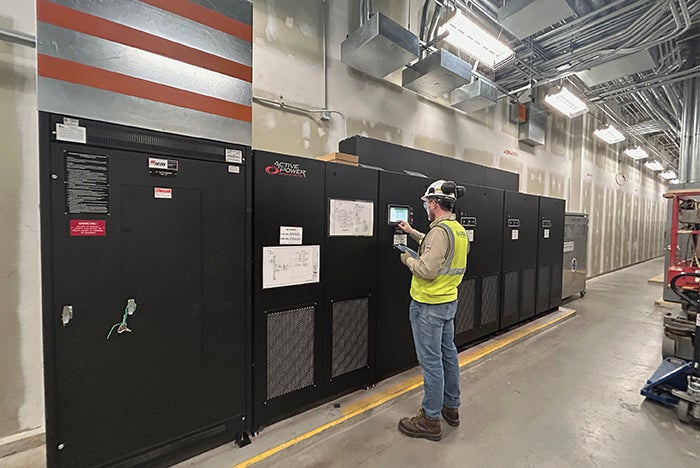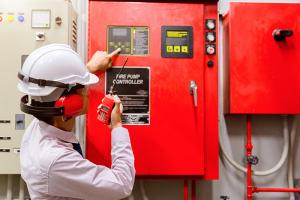A blackout testing process for facility commissioning

Wearing appropriate personal protective equipment, Richard Jackson, electrician at Children’s Hospital of Philadelphia, signals the beginning of a blackout test.
Image courtesy of Children’s Hospital of Philadelphia
Blackout testing is a crucial step in the commissioning of health care facilities projects, whether for new construction or renovations involving updates to emergency power systems.
The blackout test process ensures the reliability of the emergency power systems and the interaction of loss of normal power, transfer to emergency power and the effect on all building systems.
An understanding of the blackout testing process, definition, critical steps, lessons learned and key considerations can shed light on the criticality of a blackout test to construction projects.
An integrated test
A blackout test is a systematic test of the emergency power system to verify that all mechanical, electrical, plumbing, fire protection and alarm, and other critical equipment will operate if normal power is lost to the building. The following four major electrical tests are performed as part of the process and, in turn, test the impact on all other building systems, thus becoming a truly integrated systems test:
- Emergency power operations. This test confirms that all systems operate as anticipated when the building is running on emergency power and return to standard operating mode upon return of normal power. Sequences of operation for all equipment should describe how the systems operate under normal and emergency power conditions so these sequences can be tested.
- Load shed. Emergency power load shed sequences are appropriate for the level of criticality of each major system. A load shed sequence should be written to confirm the load sheds as anticipated to meet generator requirements. This test is performed to confirm the generator system is protected in a high-load situation, such as the loss of a generator set in a paralleling system.
- Load bank. This test confirms that the minimum load available upon a loss of normal power is reached, typically supplemented by a load bank so that the load is significant enough to reach optimal running temperature for the generator. This test is performed to confirm the generator system is protected in a low-load situation. If the project includes a rollup generator, the test also must include the interoperability of the generator with the emergency power system.
- Monthly generator test. The difference between blackout testing and monthly generator testing is that blackout testing replicates a loss of power to the building, while monthly testing exercises the transfer switches and generators in accordance with testing protocols. Properly designed systems allow technicians to perform monthly testing without interference to critical building systems and requires engineers to design the system components to behave accordingly in either a true loss of utility power or simulation testing mode.
Compliance considerations
While there is no comprehensive code or standard prescribing blackout test requirements, there are several individual code and standard sections the project team can reference to structure the blackout test for their specific building. Relevant documents include the National Fire Protection Association’s NFPA 4, Standard for Integrated Fire Protection and Life Safety System Testing; NFPA 110, Standard for Emergency and Standby Power Systems; NFPA 99, Health Care Facilities Code; the Facility Guidelines Institute’s FGI Guidelines; and local, city or state codes.
The requirements included in NFPA 4 (which is not yet adopted by the Centers for Medicare & Medicaid Services) and the FGI Guidelines (which will be renamed the FGI Facility Code for the 2026 edition) describe the steps to achieve the overall goal of blackout testing, ensuring that all required building functions occur during the loss of power. The documents state integrated building systems must be tested and validated to ensure they meet all requirements of the design intent, equipment manufacturer’s specifications and operational needs of the building. The project team should note that NFPA 4 requires that testing be conducted in a way that does not endanger the building occupants, the personnel conducting the tests, or the building and its contents or operations.
NFPA 110 includes more specific language on the testing methodology for the emergency power supply systems. Provisions for testing in new unoccupied buildings versus working in an existing occupied facility and testing requirements for different types of emergency power systems are detailed. NFPA 110 includes installation acceptance criteria for emergency power systems, such as recording the time delay on transfer, time taken to achieve a steady-state condition, a two-hour full load test and documentation of key data points throughout the operation.
It is paramount that the project team has a detailed understanding of the operations for their specific building to allow for correct application of these requirements. Before the final blackout testing, acceptance testing by the authority having jurisdiction (AHJ) is required for temporary certificate of occupancy (TCO).
The AHJ requirements and life safety inspections are focused on integrated system tests for all life safety systems. Acceptance of these tests and TCO are essential before preparing for full blackout testing.
Blackout testing process
Blackout testing begins at schematic design and requires careful planning and integration. A key component is early identification of the critical heating, ventilating and air-conditioning (HVAC) systems and appropriate integration with the building automation system (BAS).

Drew Farnsworth, senior commissioning engineer and electrical subject matter expert at Genesis AEC, conducts commissioning of a radiology uninterruptible power supply for a blackout test.
Image courtesy of Children’s Hospital of Philadelphia
At the outset of design, it is important to classify which HVAC systems are essential for building operation during normal and emergency power situations. For example, a boiler plant may be essential for maintaining temperature and humidity in critical patient areas, while a chiller plant might be required for year-round cooling of the hospital information technology and pharmacy areas.
Depending on the time of year, the boiler and chiller plants could have widely different electrical loads that would affect the power draw during a loss of normal power. Identifying these critical systems early helps ensure that HVAC equipment like boilers, chillers and air distribution units are properly backed up by the emergency power system and can continue operating on a loss of power to the building.
The engineer of record, owner and commissioning agent (CxA) must work with the BAS team to define the sequence of operations (SOO) for critical HVAC systems, ensuring the correct HVAC response during an emergency while maintaining a reasonable peak load on the generator system. For example, when a transfer to emergency power occurs, the BAS could reduce the power load by adjusting airflows in the system, reducing the total cooling load and power needed to operate the chilled water system.
Integration between the BAS and the emergency power system takes place at multiple points in a properly configured network. The systems should be integrated so the operating team is alerted when power is lost to a building and the control response can be managed accordingly. Ideally, the HVAC critical systems and associated BAS equipment are fed through the same emergency power distribution system, allowing for synchronized operation during a power loss.
For critical HVAC systems where redundancy is designed into the equipment (e.g., three chillers where two are required for operation), the BAS should manage the system by enforcing load limiting. This ensures that only the necessary number of chillers are running on emergency power (e.g., two out of the three) to prevent overloads on the emergency power system.
This is essential because when the emergency power plant is providing power to the facility’s critical equipment, the power capacity limit must be maintained. Otherwise, the power system may enter load shedding mode, where automatic transfer switches (ATSs) or breakers are activated to reduce load. ATS load shedding mode switches off power to loads to maintain the load limit of the generator and could suddenly shut down HVAC equipment operating at full load, risking equipment damage.
The final component of integrating the BAS and emergency power systems is thorough documentation. Facilities professionals should ensure that the design and operations teams (i.e., mechanical, electrical and BAS) communicate at the schematic design phase to confirm that HVAC systems are appropriately backed up and can respond to normal and emergency power conditions.
The teams should create clear testing protocols for blackout events that replicate multiple power loss and restoration scenarios and simulate monthly testing. Facilities professionals also should maintain detailed documentation of the entire system configuration, including how the HVAC systems, emergency power plant and BAS are integrated. This will aid in troubleshooting, system upgrades and maintenance.
Construction considerations
During construction, a thorough review of the generator system and BAS submittals ensure SOOs defined in design are reflected in the shop drawings.
Tight coordination between the emergency power, BAS and HVAC systems ensures that the building operates smoothly during power outages and emergency testing for which the CxA develops the functional test scripts for commissioning. Thoughtful design, communication and collaboration during the design and shop-drawing processes safeguards against potential disruptions and supports energy efficiency and long-term building reliability.
“Capturing the building owners’ goals when making the building automation work together with the emergency power system requires careful collaboration between the owner, design team and subcontractors,” says Christopher Gale, account executive at Johnson Controls, headquartered in Ireland.
The commissioning of emergency power, BAS and HVAC systems will be impacted by the construction schedule and time of year the tests are performed. In large projects, the HVAC equipment provides most of the load for the emergency power system, and systems tests are impacted depending on the time of year and region of the country. The cooling and/or heating system must be tested in season to confirm the system can operate at maximum load, which may be challenging to pair up with the emergency power systems test to meet targeted facility occupancy.
Emissions seasonal limits and regulatory restrictions also must be considered when scheduling testing. While in operation, generators produce various pollutants such as nitrous oxides and volatile organic compounds. In some areas of the country, ozone levels become so high that generator testing is limited to specific times of the day to curb further ozone generation.
The scale of blackout testing varies based on the project size and complexity, with full building tests being conducted for new construction facilities, while localized testing may be completed for renovation and infrastructure upgrade projects. Blackout testing also may be conducted periodically for testing existing systems for maintenance needs, emergency preparedness and/or before upgrades to infrastructure systems.
An example of a localized small-scale test is for a patient unit renovation, where prior to occupancy the normal power breakers serving the area are locally turned off to check the emergency power and lighting in the unit. An example of a localized test for an infrastructure upgrade is for a centralized radiology uninterruptible power supply (UPS) addition, where the localized test is performed at the normal breaker serving the UPS ATS.
On large-scale projects, the commissioning process for blackout testing is iterative. As a first step, systems such as emergency generators, paralleling gear, ATSs, fire alarms and pumps, elevators and stair pressurization are started up, and functional testing is performed on each individual system. The next step is testing required by the AHJ to obtain the TCO.
It is advantageous to layer on BAS and security system tests with the contractor and CxA ahead of the full blackout test. The full blackout test should be scheduled prior to occupancy, with enough time to make needed revisions prior to go-live. Typically, the TCO is already received, but there could be unexpected issues that arise and require updating prior to go-live.
“A stitch in time saves nine,” says Randy Stoddard, LME, CHEPP, supervisor of electricians at Children’s Hospital of Philadelphia. “A scheduled shutdown for a predetermined time is better than an unscheduled shutdown for an undetermined amount of time.”
The owner’s team members participating in the test are positioned to observe and report on system performance. Stakeholders should note anything unexpected. To close the event, all parties participate in a debrief once all information is assembled and action items are developed. To mitigate risk to the scheduled completion date, facilities professionals should allow enough time for testing and issue resolution.
“There is no better test for an emergency power system than a full blackout test under load,” says Drew Farnsworth, senior commissioning engineer and electrical subject matter expert at Genesis AEC in Blue Bell, Pa.
A critical requirement
Commissioning is a critical requirement in FGI 1.2-8.1 that helps ensure reliable systems for patient protection and safety.
Design engineers and CxAs must include testing requirements within the contract documents so that contractor and vendor support for the tests are included in the scope of work. Detailed specifications should include full scope requirements, from blackout simulation to load bank use to monthly testing simulation with all building systems online.
The building owner’s construction team should lead this process beginning in design to ensure the testing requirements are covered in the contract documents and remain heavily involved through construction to final testing.
The blackout test is a fully integrated test that increases the reliability of the facility emergency power system.
Related article // Blackout tests require team and stakeholder collaboration
The main participants in a blackout test are the contractors, commissioning agent, engineers and the building owner.
The owner’s team is typically led by professionals with expertise in design, construction and operations. The team manages the various departments that will rely on the emergency power system, such as maintenance, security, information technology, biomedical engineering, sterile processing, pharmacy, clinical leadership, safety and infection prevention as well as building occupants and the commissioning professionals, engineers and contractors.
It is important that facilities professionals identify and communicate with stakeholders prior to the actual test so that participants are engaged, understand their role and recognize the importance of the test.
“Blackout testing is a critical step in the commissioning process that requires engagement and involvement from all stakeholders and end users,” according to Robert F. Murray, PE, CHFM, director of maintenance at Children’s Hospital of Philadelphia. “The test gives occupants a true electrical outage experience.”
During the test, communication tools, such as text chains and virtual meetings, are important in keeping participants informed during each step. Digital survey tools to capture participants’ comments during the test must be developed with ease of use and data review in mind.
Mary Alcaraz, PE, LC, LEED AP, is senior project manager; Beth Lorenz, PE, is director of engineering; and DeVaughn Roberts, PMP, is project manager at Children’s Hospital of Philadelphia. They can be reached at alcarazm@chop.edu, lorenzb@chop.edu and robertsd6@chop.edu.




